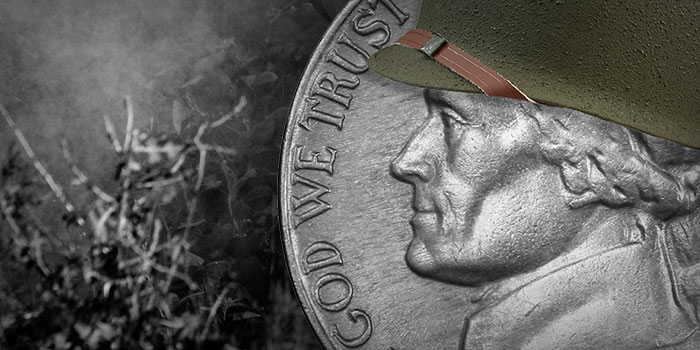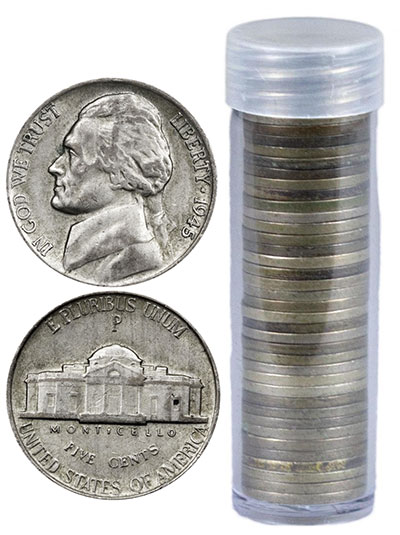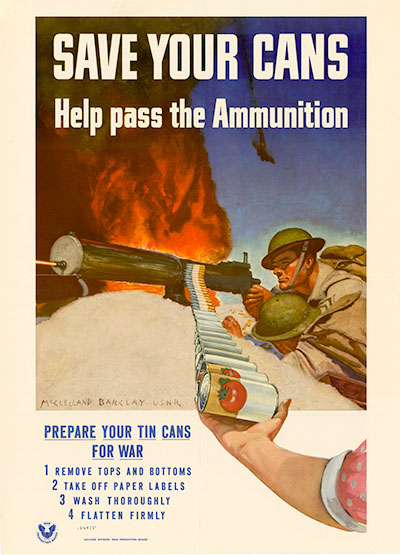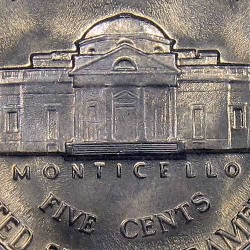
By Bullion Shark LLC ……
About 10 months into the U.S. involvement in World War II that begin in December 1941 after the Pearl Harbor attack, the United States Mint began producing silver nickels. These coins were made of an alloy of 56% copper, 35% silver and 9% manganese rather than 75% copper and 25% nickel as the coins had been made since 1866. So why was the metallic composition of the coins changed?
Copper and especially nickel were both metals with strategic uses for the war and were more valuable than silver at the time. For example, nickel could be used to harden the metal in heavy tanks and for other military purposes.
Earlier in 1942, on March 27, a law was enacted that called for completely eliminating nickel from five-cent coins, suggesting the coins be made of 50% silver and 50% copper. This plan would have saved 435 tons of nickel and copper for the war effort, but technical problems were encountered. In particular, those substitutes for nickel would not work properly in coin-operated machines because the machines test the weight of the coins, which would require retrofitting all those machines. In addition, silver does not have magnetic qualities which were also needed for the machines.
 Various possibilities were examined including experiments to find an alloy without nickel that would not be rejected by the machines or reviving the silver half dime. Eventually, it was discovered that adding some manganese to the alloy would create the necessary magnetism, which is what led to the particular nickel composition of 56% copper, 35% silver, and 9% manganese.
Various possibilities were examined including experiments to find an alloy without nickel that would not be rejected by the machines or reviving the silver half dime. Eventually, it was discovered that adding some manganese to the alloy would create the necessary magnetism, which is what led to the particular nickel composition of 56% copper, 35% silver, and 9% manganese.
Silver War Nickels
This alloy was used from mid-1942 through December 1945, six months after the war ended when nickel and copper were no longer needed in large quantities. Prior to October 1942 nickels made of the regular alloy continued to be made at the Philadelphia and Denver Mints.
To make it easy to spot the silver war nickels from other nickels, a large “P” mintmark was added on the reverse side of the coins above the dome of Monticello, Jefferson’s famous estate in Virginia. In addition, since coins made of the normal alloy had already been produced at Philadelphia earlier in 1942, the silver nickels made there were the first U.S. coins struck at that mint that sported a mintmark. This change was also made to make it easier to spot the coins when they were redeemed at banks.
The silver nickels were also easy to spot when freshly minted because they had a dazzling brilliant finish on them that was whiter in appearance than regular nickels and often with sharp striking of the details. However, with time the finish tarnished and toned, often becoming a dull grey and less attractive, which also happened with the 1943 steel pennies made for the war effort too.
Recent research adds an interesting twist to why the silver war nickels were made.
 An article by Mark Benvenuto published in The Numismatist magazine in 2000 explained that the change in nickel alloy may have saved as much as 827,163 pounds of nickel but that the amount was actually insignificant since 300 million pounds of nickel were produced annually during World War II. The author speculates that the real reason for the change in composition was probably to boost the morale of American citizens by showing the Mint was doing its part in the war effort by doing without nickel.
An article by Mark Benvenuto published in The Numismatist magazine in 2000 explained that the change in nickel alloy may have saved as much as 827,163 pounds of nickel but that the amount was actually insignificant since 300 million pounds of nickel were produced annually during World War II. The author speculates that the real reason for the change in composition was probably to boost the morale of American citizens by showing the Mint was doing its part in the war effort by doing without nickel.
This is an interesting theory, and it is also worth noting that at the same time the U.S. made this change, other countries were making similar changes to their coinage, such as Canada, which also removed nickel from its five-cent coins during the war.
U.S. silver nickels were withdrawn from circulation in the mid-1960s when the silver content of coins exceeded their face value, but once in a while they are still found in change.
War Nickel Value
How much are silver war nickels worth?
Silver nickels contain .05626 ounces of silver, which with silver at a current spot price of $24 per ounce, makes any silver nickel worth at least $1.35 each. Circulated examples are easy to source today and can be purchased in rolls for about their silver value.

Naturally, some of these coins are worth much more, especially if they are in high mint state condition and include Full Steps details on the reverse, or if they are one of the rare variety coins such as the 1943-P 3 over 2 (worth from $125 in XF to as much as $5,500 in MS67 Full Steps), 1943-P Double Die (worth from $55 in XF to $300 in MS60 and as much as $7,500 in MS67 Full Steps), or 1945-P Double Die reverse (worth from $52 in XF to $275 in MS60 and as much as $11,500 in MS66 Full Steps).
A type example of a silver nickel in MS60 (which is not hard to find) is worth $6, while an MS65 is $25 and MS67 $70 and examples with Full Steps are worth more. A top-grade MS68 FS is worth over $6,000.
A set of the 11 date and mintmark silver war nickels in nice mint state (about MS63) can be had for $150.
1943 War Nickel
The highest mintage silver war nickel is the 1943-P, with 271,165,000 coins struck. About 20% of these coins can be found with 5 of 6 steps on Monticello, while examples with all 6 steps are scarce.
In addition to the 1943-P 3 over 2 (with somewhere around 100-200,000 examples made but only a couple hundred mint state coins have been found) and the rarer 1943-P double die variety coins (where there appear to be two eyes on Jefferson instead of the one shown in the left-facing profile on the obverse), some of these coins were also struck from the prior alloy of 75% copper and 25% nickel, which were made in error from leftover planchets. There are also some 1942-P nickels made of the original alloy as well as some 1946 nickels made with the wartime alloy.
To this day, the silver war nickels continue to fascinate coin collectors. There are many different ways to collect the coins depending on your interests and budget and you may even still find one in change. And if you look closely at your nickels, you might even find one of the scarcer variety coins.





I got a full copper war time nickel
What about the value of the war dimes, usa, mint dated 1943, uncirculated?
As I understand this site, it’s more about information and history rather than a “whatzit worth” service. There are lots of sites that can give up-to-date values; one I’ve used a lot is numismedia dot com but it’s just one of many.
Anyway, if your coin’s an average uncirculated specimen you’d be looking at a retail value of $7 for Philadelphia and Denver coins to $15 if it’s from San Francisco.
The “however” is that a small percentage of Mercury dimes have other characteristics that _might_ make them more valuable, but expert evaluation would be needed.
i have a1943 d war nickel in pretty good shape how would I go buy sending it to some one to get it cerfied I think it’s hard to put a price on the history behind it if you have one be grateful in joy it
I ALSO have a war nickel WITH the p on top of the dome but there a missing right side of the building missing
I have a 1943 s MS 66 and a 1945d MS 66 could you tell me the value is either coin worth anything
I’ve got three 1943/2 P War Nickels. Thay are not that rare. One of them I found metal detecting.
I have a 1942 no mint silver nickel is it worth anything
This site is very helpful . Thank you .